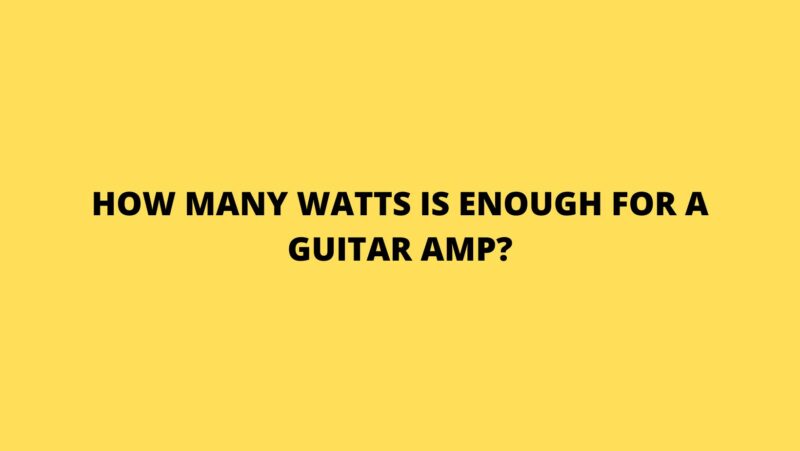In the world of music, the guitar amp’s wattage serves as the driving force behind the amplification of your sound. The question of how many watts are enough for a guitar amp is a common query among musicians seeking the perfect balance of volume, tone, and versatility. This article aims to provide a comprehensive guide to help you understand the intricacies of guitar amp wattage. We’ll explore the factors that influence wattage requirements, delve into different scenarios and genres, and offer expert insights to assist you in making an informed decision that aligns with your musical aspirations.
The Significance of Guitar Amp Wattage
Before diving into the specifics of determining the appropriate wattage for a guitar amp, it’s crucial to grasp the fundamental role that wattage plays in shaping your sound:
- Guitar Amp Power: The wattage of a guitar amp determines the amount of electrical power it can use to amplify the sound produced by your guitar.
- Volume and Headroom: Higher wattage amps generally offer more volume and headroom, allowing for cleaner tones at louder volumes before reaching distortion.
- Tone and Dynamics: Wattage can impact the tonal characteristics and dynamics of your guitar sound, influencing factors like warmth, clarity, and sustain.
Factors Influencing Guitar Amp Wattage
- Performance Environment: Consider where you’ll be playing most often. A bedroom practice amp requires far less wattage than an amp for gigging in larger venues.
- Volume Needs: Determine the volume levels you intend to achieve. Smaller wattage amps are suited for practice, while larger wattage amps are better for live performances.
- Genre and Style: Different genres demand varying levels of clean headroom and distortion. Blues and rock genres may benefit from tube saturation, while metal requires higher wattage for extreme distortion.
- Band Context: If you’re playing with other musicians, consider how your guitar amp will blend with other instruments and whether you need the power to cut through the mix.
- Tone Preferences: Your tonal preferences also play a role. If you value pristine cleans and subtle dynamics, lower wattage might suffice. If you prefer raw distortion, higher wattage amps are beneficial.
Determining the Right Wattage
- Bedroom Practice: For bedroom practice, 5 to 15 watts can suffice, providing enough volume for personal playing without disturbing others.
- Small Gigs and Rehearsals: Amps in the range of 15 to 30 watts are suitable for small gigs and rehearsals with other musicians.
- Medium-Sized Venues: For medium-sized venues, consider amps with wattage ranging from 30 to 50 watts to ensure sufficient projection.
- Large Venues and Outdoor Shows: Amps in the range of 50 watts or more are ideal for large venues and outdoor performances where volume and projection are paramount.
Styles and Scenarios
- Clean and Crunchy Tones: If you’re playing genres like jazz, blues, or classic rock that rely on clean and slightly distorted tones, lower wattage amps with good tube saturation are effective.
- High-Gain and Metal: For genres like metal that demand extreme distortion, higher wattage amps (50 watts or more) with strong clean headroom are essential.
- Versatile Amps: If you require versatility across genres, consider medium wattage amps with a good balance of clean and distortion capabilities.
Considerations for Tube vs. Solid-State Amps
- Tube Amps: Tube amps tend to have a warmer and more dynamic tone. A lower wattage tube amp can achieve breakup and saturation at lower volumes, making it suitable for bedroom practice.
- Solid-State Amps: Solid-state amps offer clean tones and consistent sound across different volume levels. They are often chosen for their reliability and affordability.
Playing Dynamics and Wattage
- Dynamic Sensitivity: Lower wattage amps tend to break up and distort more easily, providing responsive dynamics that react to your playing style.
- High Wattage Dynamics: Higher wattage amps can maintain cleaner tones at louder volumes, accommodating aggressive playing without losing clarity.
Listening Tests and Experimentation
- Try Before You Buy: Whenever possible, test different wattage amps to experience how they respond to your playing style, volume requirements, and genre preferences.
- Gig Simulation: If your goal is live performances, simulate a rehearsal or gig situation during testing to assess how the amp holds up in terms of volume and projection.
Conclusion
Selecting the right wattage for your guitar amp is a decision that depends on a multitude of factors, from playing environment and volume needs to genre preferences and tonal expectations. By understanding the dynamics between wattage and sound characteristics, you can choose an amp that complements your playing style and musical aspirations. Whether you’re seeking the subtle nuances of jazz, the crunch of rock, or the intensity of metal, the insights shared in this article empower you to make an informed decision that resonates with your musical journey. With careful consideration and a keen ear, you can embark on a sonic adventure where amplifier wattage becomes the driving force behind an unforgettable musical experience.


